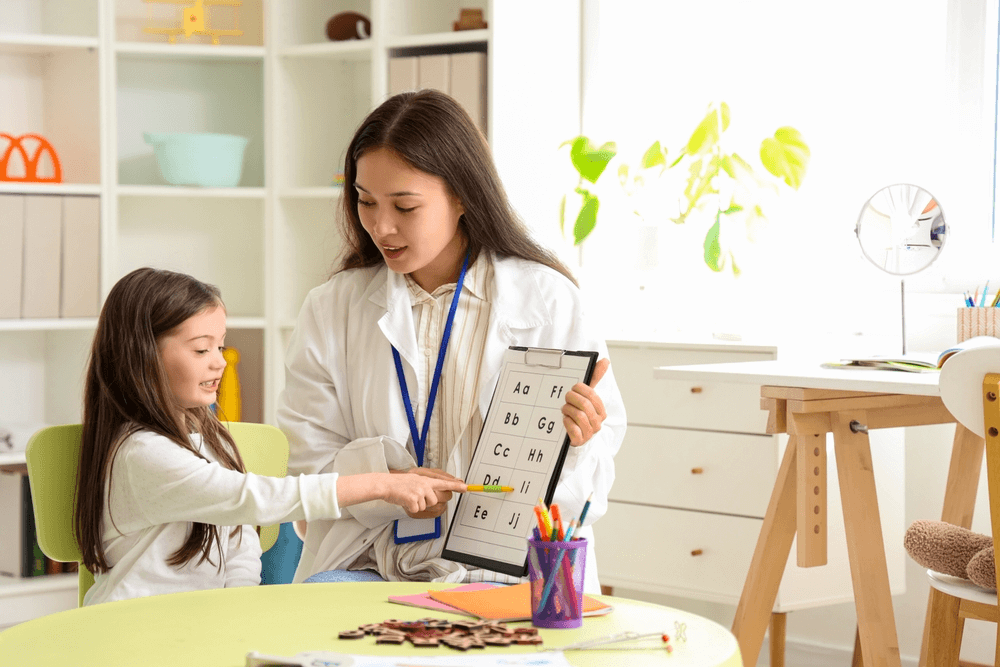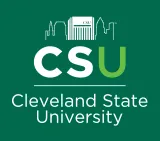What Are the Nine Broad Areas of Knowledge in Speech-Language Pathology?

In broad terms, speech-language pathologists (SLPs) treat children and adults with speech, language, communication and swallowing disorders. Many speech-language pathologists choose this career because they want to positively impact people’s quality of life.
However, an SLP’s skill set and scope of practice go far beyond the general public’s view of a practitioner helping a child with a stutter or an elderly patient with swallowing concerns. SLPs are specially trained in many areas and work with diverse populations in various environments, including schools, hospitals, rehab centers and private practices.
The American Speech-Language-Hearing Association (ASHA) has summarized the speech-language pathology scope of practice into broad areas of knowledge.
This blog looks at the areas of speech-language pathology in which master’s-prepared SLPs assess, diagnose and treat communication and swallowing disorders in nine defined areas.
1. Speech Sound Disorders
Speech sound disorders (SSDs) are also referred to as articulation and phonological disorders. SSDs indicate difficulty articulating certain sounds, such as “sh,” not pronouncing certain letters or making word speech mistakes past the appropriate developmental age in children. An example would be saying “baba” instead of “bottle.”
SSD causes in children include developmental disorders, genetics, physical problems, hearing loss, and brain damage or neurological disorders (childhood apraxia). Apraxia occurs when the brain fails to effectively instruct the facial muscles to move properly, resulting in the production of incorrect sounds.
Adults may also have SSDs that started when they were children or developed after a stroke or brain injury (dysarthria). Dysarthria is a motor speech disorder that may present as slurred speech.
Speech-language pathologists assess SSDs by listening to how the words sound and seeing how the lips, jaw and tongue move. Treatment includes teaching the correct way to produce the sounds, learning to recognize when the sounds are incorrect and practicing the sounds in various words and sentences.
2. Receptive and Expressive Language Disorders
Language disorders appear when someone struggles to understand language (receptive language) or share thoughts, ideas or feelings (expressive language). This type of disorder can develop in both oral and written communication.
The components of language include speech sounds (phonology), the structure of words (morphology), syntax (sentence structure), semantics (meaning of words), and socially and functionally appropriate communication (pragmatics).
While some language disorders do not have a known cause, adults may develop receptive and expressive language disorders as a result of a brain injury. Some childhood developmental language disorders can be attributed to a specific diagnosis, such as autism or Down syndrome.
Treatment and intervention strategies vary by person and disorder, but individuals may benefit from a strengths-based approach that identifies their strengths and allows them to make their own choices.
3. Fluency Disorders
Fluency describes how words and phrases flow when we speak — the rhythm (prosody) of speech, including continuity, smoothness and rate. Stuttering and cluttering are common fluency disorders that typically develop in childhood before age four.
According to ASHA, “Children and adults who stutter also frequently experience psychological, emotional, social, and functional consequences from their stuttering, including social anxiety, a sense of loss of control, and negative thoughts or feelings about themselves or about communication.”
Speech-language pathologists consider the individual’s age and unique life circumstances when treating and managing disfluencies. ASHA notes that successful therapy can be a life-changing experience for individuals with fluency disorders. Patients report positive changes in self-confidence, self-advocacy and increased social participation and enjoyment.
4. Voice and Resonance Disorders
Voice and resonance disorders are different conditions. Our voices are the sounds air makes when pushed from the lungs and passed between the vocal cords. When vocal cords don’t move or vibrate as they should, voice disorders manifest as pitch, volume or tone differences.
Voice disorders can be organic, structural, neurological or functional. SLPs intervene and often collaborate with otolaryngologists/laryngologists and other medical professionals to develop specialized treatment plans based on what is causing the problem, including voice therapy, pharmacology or surgery.
Resonance disorders are the differences in tones based on how the sound filters through the mouth, nose and throat. Resonance disorders result from too much (hypernasality) vibration in the nasal cavity, too little (hyponasality), or cul-de-sac resonance, when the sound vibration is trapped in the nasal area with no way out.
Children with cleft palates, enlarged adenoids or craniofacial abnormalities are at risk for resonance disorders.
SLPs approach treatment based on whether the disorder is structural or functional or if articulation errors are due to mislearning. Treatment and management include surgery, prosthetics, pharmacology and behavioral speech therapy.

5. Oral communication skills
Oral communication skills can be impacted by hearing loss, deafness and auditory processing disorders in children
Hearing Loss and Deafness
With hearing loss and deafness, early detection and early use of assistive listening devices have been shown to positively affect a child’s ability to acquire oral language skills.
How speech-language pathologists treat children with hearing loss or deafness depends on the child’s age, the onset of hearing loss, the age at which the loss was detected, the severity of the loss and when listening technology (amplification) was first used. Treatment options are highly dependent on the family’s chosen methodology for communication.
Aural habilitation services for children with hearing loss include training to distinguish one word from another, using visual cues to provide context to the message, skills development and more.
Auditory Processing Disorders
Often called central auditory processing disorder (CAPD), this condition affects listening, communication, academic success and social well-being.
A team approach is the best practice for addressing auditory processing deficits in school-aged children. Speech-language pathologists collaborate with audiologists, teachers, parents and school counselors to provide and manage treatment.
Treatments for CAPD include skill correction, modifications to the learning environment and compensation strategies.
6. Feeding and Swallowing Disorders
Feeding Disorders
Pediatric feeding disorders (PFDs) are different from swallowing disorders. PFDs occur when a child has difficulty eating when compared to same-age peers. PFDs can be acute (present for less than three months) or chronic (present for three months or more). Atypical eating behaviors, such as food selectivity or food avoidance, are examples of PFD.
Speech-language pathologists consider the child’s age, abilities and specific feeding problems to determine the best treatment and management of the disorder. Often, a multidisciplinary approach with other medical professionals is helpful for children with complex conditions.
Swallowing Disorders
Dysphagia (a swallowing disorder) can affect children and adults. Swallowing occurs in three phases, so a problem can develop in one or more of these phases, including:
- Oral phase (mouth) — the sucking, chewing and moving of food or liquid into the throat
- Pharyngeal phase (throat) — the swallowing and squeezing of the food down the throat
- Esophageal phase — the opening and closing of the esophagus, squeezing the food down to the stomach
Although not part of the communication process, speech-language pathologists are experts in the field of swallowing disorders because their comprehensive education in speech anatomy is very closely related to the anatomy of swallowing.
SLPs assess, diagnose and treat dysphagia in adults and children in various ways, some with medical intervention from a doctor, depending on the presenting problem.
7. Cognitive Aspects of Communication
Cognitive communication disorders affect a person’s ability to communicate effectively and perform activities of daily living due to impaired functioning in one or more cognitive processes, including, but not limited to:
- Attention
- Executive functioning
- Language
- Memory
- Problem-solving
A person with a cognitive communication disorder may have difficulty paying attention to a conversation, concentrating in a loud environment, staying on topic, remembering information or following directions.
Alzheimer’s disease or other forms of dementia, stroke or brain injuries and tumors are leading causes of cognitive communication disorders.
SLPs approach treatment to help individuals regain their communication skills and cognitive function with personalized treatment plans that may include:
- Therapeutic techniques to improve memory, attention and other essential communication skills
- Compensation strategies to manage their communication deficits using memory aids
- Tools such as speech-generating devices or other external aids
Specific treatment depends on the individual’s needs and goals for a better quality of life.
8. Social Aspects of Communication
Social aspects of communication are fundamental for spoken and nonverbal expression and comprehension, empowering individuals to share experiences, thoughts and emotions.
Social communication skills demonstrate the ability to adjust one’s style of speech based on context, to understand the perspectives of others and to use language appropriately.
Social communication disorders (SCD) become apparent when an individual doesn’t follow acceptable norms for conversation and storytelling, doesn’t understand something that is not plainly stated or misinterprets the context, among other things.
Speech-language pathologists step in with treatment and intervention strategies that may include, but are not limited to:
- One-on-one and group interventions for skill building and practice in social situations
- Computer- and video-based programs for teaching language skills, social understanding and problem-solving
- Behavioral interventions and techniques to modify behaviors or teach new ones
- Peer interventions that teach strategies to facilitate play and social interactions
- Social scripts to teach how to use language during social interactions
- Social skills groups that use instruction, role play and feedback for how to interact appropriately with peers
- Social stories to explain social situations and to teach appropriate behaviors and responses
9. Augmentative and Alternative Communication
Augmentative and alternative communication (AAC) techniques benefit people with speech, language, reading and/or writing limitations due to disabilities or neurological differences such as autism.
AACs are used to enhance and improve communication, whether in spoken or written form. According to ASHA, “AAC falls under the broader umbrella of assistive technology, or the use of any equipment, tool, or strategy to improve functional daily living in individuals with disabilities or limitations.”
AAC uses various tools and techniques to aid in communication, including:
|
Unaided Techniques |
Aided Low-Tech Tools |
Aided High-Tech Tools |
|
Body language |
Objects/pictures/line drawings |
Computer/tablet/smartphone |
|
Facial expressions |
Photographs |
Single-message devices |
|
Finger spelling |
Picture and letter boards |
Recordable/digitized devices |
|
Gestures |
Visual schedules |
Speech-generating devices |
|
Verbalizations |
Writing |
|
|
Vocalizations |
SLPs screen, assess, diagnose and treat those who need AAC intervention. They train health professionals, family members and others about AACs and their impact on quality of life. They advocate for the individual, reduce barriers to care and facilitate access to other services when necessary.
Get on the Right Path to a Career Helping Others
If these areas of speech-language pathology interest you and you want to help improve people’s quality of life, earning a master’s degree is the first step. Cleveland State University’s (CSU) online Master’s in Communication Sciences and Disorders program will lead you on the path to becoming a speech-language pathologist.
While there are many environments in which you can practice as an SLP, if you want to work in the Ohio public school system helping children, CSU offers a Teacher Licensure pathway that allows you to specialize in the classroom. This pathway includes additional courses that incorporate understanding current federal legislation for school-based SLPs.

